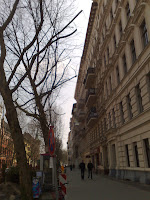 MONUMENTAL STORIES
MONUMENTAL STORIESRENATO REDENTOR CONSTANTINO
GMAnews.tv, May 13, 2009
It's likely no one ever asked Ebe Dancel if he meant it this way when he wrote the first lines of Sugarfree's haunting classic, Kwarto. But I suspect he'd agree if I tell him the moment his songs are first played in public, they're actually no longer his.
If there was ever a soundtrack to the chapter on memory and monuments in a book I've been writing, Kwarto would be one of the big songs, if not the opening tune. The song begins as an unintended homage to Lou Reed but proceeds to open its own vistas.
Remembrance is like this sometimes. On a slow day in a cafeteria an odd refrain from outside wafts in or someone a few tables away hums something familiar; a sense of place sits beside you, or a person from the past, a piece of conversation, and things melt and merge and for a few moments the song is yours.
Last year I chased the ghost of a storied officer, Col. John Miller Stotsenburg, who arrived with the armed forces of the US a century and a decade ago to annex the Philippines. Stotsenburg fell in what was known once as a town in Bulacan called Qingua -- the site of furious volleys from Filipino revolutionaries attempting to halt the advancing imperial US juggernaut. Called Plaridel today, the town contains other exquisite delicacies aside from fried native duck.
Every 23rd of April, the proud local government of Plaridel celebrates the Battle of Qingua as a non-working holiday to mark the vigilance of local heroes led by Juan Evangelista and Pablo Maniquiz, who were part of the forces that killed Stotsenburg and blocked the march of the US army.
Ironically, for decades a marker stood in the very place where Stotsenberg fell -- to mark the death of the US officer. Then in 1999 the local government decided to restore dignity to their town and country. It commissioned the distinguished sculptor from Jolo, Toym Imao, to erect a huge mural -- a grand tableau that gave face to Maniquiz, Evangelista and other unsung Philippine fighters which today frames the original Stotsenburg memorial, which was left intact onsite to carry on the conversation between past and present.
National memory is a strange thing. Sometimes it's a lurch across time and space that takes you to places where the pen and the sword can't reach. Sometimes it's like a dream, full of rushing colors. Other times it's like the sleep of the dead; there is nothing except the second before waking.
In 1991, the magnificent vote of twelve brave Filipino Senators served the long overdue eviction notice to all US military bases on Philippine soil. Huge tracts of land, sea and air throughout the Filipino archipelago which Americans ruled for almost a century came once more under Philippine authority.
Camp O'Donnell was reclaimed and so was Subic; Clark became ours again and yet what did we do with it? In 2003, Philippine officials christened a massive park in Clark using the original name of the US airbase. The space was named Stotsenburg Park, after the US officer gunned down in 1899 in Qingua. Not Diokno; not Tañada, Recto or Sakay,who all fought against American rule and for Philippine sovereignty. The felled occupier was worthier.
The same Imao was commissioned to build the Clark park monument, and there he built a thing of grace: Stotsenburg bigger than life, riding a handsome horse and looking afar with two other US sentries on horseback flanking him. But bless Imao for his subversive wit: across the road, opposite the statue of the US invaders, a similar monument which was not part of the original design was erected: four Filipino revolutionaries about to light an immense cannon aimed directly at Stotsenburg.
I remember walking down a narrow dirty road in Caloocan early last year. Clotheslines crisscrossed the the street, children were playing and vendors were selling fried food under the shade of tattered tarpaulins. On a transistor radio Dancel's voice teased out Kwarto's first verse and the fat sound of Jal Taguibao's bass line pulsed out despite the tinny speakers.
I spent a whole day in that street laughing with kids and asking bemused adults and senior citizens about the name of the road they had lived in most of their lives. No one really remembered why it was called "Stotsenburg St." and they all had a great time theorizing about the person or thing behind the name and when and why it was named. Not even the archivists of Caloocan's city hall whom I later visited could remember where the name came from.
Such is life. Twists and turns and twists.
To get to Stotsenburg St. from the main highway of Metro Manila, you pass through an avenue called Heroes del 96, named after the revolutionaries of 1896 who led the victorious campaign against Spain in order to build the republic - the first in Asia - which the US soon extinguished. Turn right at the end of Heroes del 96 and you reach the streets of Vibora and Del Pilar, named after Filipinos who fought against the US annexation of the Philippines. Turn left, its Stotsenburg St.
I don't know if anyone ever asked Ebe Dancel if the first lines of his song was about his country today. I think it is.
"Naglilinis ako ng aking kwarto / na punong-puno ng galit at damit. / Mga bagay na hindi ko na kailangan. Nakaraang hindi na pwedeng ipagpaliban."
We are a people obsessesed with the costumes of modernity, a forgetful people living in a land simmering with rooted ambient enmities - a place where the past will eventually catch up with the consequences of forgetting.
The future will not be pretty without remembrance. It rarely is. #
No comments:
Post a Comment